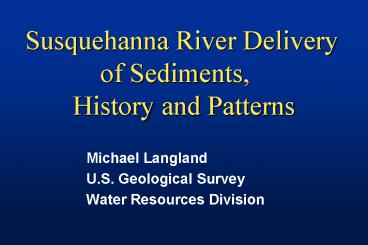Susquehanna River Delivery of Sediments, History and Patterns - PowerPoint PPT Presentation
Title:
Susquehanna River Delivery of Sediments, History and Patterns
Description:
Susquehanna River Delivery of Sediments, History and Patterns Michael Langland U.S. Geological Survey Water Resources Division Discussion Topics Changes in River ... – PowerPoint PPT presentation
Number of Views:75
Avg rating:3.0/5.0
Title: Susquehanna River Delivery of Sediments, History and Patterns
1
Susquehanna River Delivery of
Sediments, History and Patterns
- Michael Langland
- U.S. Geological Survey
- Water Resources Division
2
Discussion Topics
- Changes in River Flows
- Depositional Characteristics/Patterns
- Trapping Efficiencies
- Potential Impacts to the BAY
3
(No Transcript)
4
(No Transcript)
5
(No Transcript)
6
(No Transcript)
7
Lower Susquehanna River Basin
8
Susquehanna River Sediment Transport and Budget
9
Susquehanna Sediment Transport
- Obvious relation to flow
- Approximately 3.1 MT sediment transported to
Reservoirs, Long-term trapping ratio approx 55 - 25 of sediment load is delivered below
Harrisburg (12 of basin) - Ratio has changed over time
10
Sediment Storage Capacity Conowingo Reservoir
11
Sediment Loads for all RI Stations
12
Susquehanna River Floods
- Period 1900-1999 (at Harrisburg)
- - Flood stage 17 ft 320,000 cfs 3-4 yrs
- - 28 floods since 1900
- - 100 yr flood 740,000 cfs 1972 and 1936
- Period 1900-1999 (Reservoirs)
- - 380,000 - 400,000 cfs needed to scour
- - 14 flow events gt scour threshold
13
Wendy McPherson USGS - 9/20/04
14
Susquehanna River
Bay Bridge
15
(No Transcript)
16
Types of Flow Events
- Frequent events 1 or 2 yr
- - Bank Full Discharge (250,000 cfs)
- Episodic events 5-10 yrs
- - moderate amount of scour (380-600,000
- cfs)
- Catastrophic events 50 or 100 year floods
- - greatest amount of scour, load, and
enviromental damage (gt600,000 cfs)
17
Sediment Transport (Wolman and Miller 1960)
- 90 of the sediment is transported in flows that
occur once every 5 years or less - Greatest part of the sediment removed from the
basin during the POR was carried by moderate
flows not by catastrophic floods - Analysis based upon Eastern US streams, Western
US streams opposite
18
Susquehanna Sediment Transport (at
Harrisburg)
- Period 1900-1999
- - Sed load from 20 largest flows 75 M tons
- - Sed load next 80 largest flows 70 M tons
- - Intervening high flows (2-3/yr) 100 M tons
- - Base flow
75 M tons -
Total 320 M tons
19
Susquehanna Sediment Budget
- Period 1900-1999 (at Harrisburg)
-
Total 320 M tons - Period 1900-1999 (to Reservoirs)
- Total 700 M tons
- Period 1930-1999 (trapped in Reservoirs)
- Total 300 M tons
- Period 1930-1999 (scoured in Reservoirs)
- Total 65 M tons
20
Estimated Sediment Load to Reservoirs 1900-2000
120
100
80
Sediment Load (millions of tons)
60
40
20
0
Year
21
Flow Events
- Catastrophic events short term, greatest
sediment load and scour, greatest environmental
damage - Episodic events - long term, greatest sediment
load and scour, lesser environmental damage - Continue and increase stream restoration and
monitoring efforts
22
Sediment Storage Capacity Conowingo Reservoir
23
Sediment Storage Capacity Conowingo Reservoir
24
Catastrophic and Episodic Scour Events
- Above 400,000 cfs needed to scour
- 1972 (20 M), 1975 (3 M), 1996 (10 M)
- Approximately 33 M tons of sediment scoured
- About 42 M tons remain
25
(No Transcript)
26
Predicted Sediment Scour vs. Flow
30.0
Scour estimates
95th percentile
95th percentile
25.0
Expon. (Scour estimates)
1972
1972
20.0
15.0
tons)
Predicted scour (millions of
1996
10.0
2004
1996
5.0
1975
1975
0.0
300
400
500
600
700
800
900
1,000
1,100
1,200
Instantaneous Flow (times 1,000)
27
Total Deposition in the Reservoirs
- Constituent Safe
Total - (tons) Harbor Holtwold
Conowingo (1990) - Ammonia 34 k 2.2 k
63 k 100 k - Organic N 310 k 35 k
470 k 815 k - Phosphorus 75 k 8 k
140 k 220 k - Sediment 90 M 14 M 155
M 250 M - Iron 1.5 M 220 k
3.5 M 5 M - Aluminum 545 k 100 k 1.5
M 2.1M - Manganese 140 k 12 k 250
k 400 k - Coal () 10 15
6 --
28
When will the Reservoirs fill
- Predictions after 1996 at steady state no
change in transport, scour, trap efficiency - - 17 to 20 years
- Revisions in 2001 with changes in transport,
scour, trap efficiency - - 20 to 30 years
- Predictions (2004) with future changes
- - Ivan added 1.5 to 2 years
- - 20 to 25 years
29
Implications when Reservoirs fill
- Loads entering will approximate loads leaving
- - Sediment 200-250 increase
- - Total phosphorus 30-40 increase
- - Total Nitrogen 2 increase
30
Summary
- Decrease in sediment transport rates from
watershed into the Reservoirs - Distinct spatial change in sediment sources
- Reservoirs continue to fill and may reach SSC in
20-25 years - Delivery of sediment and any associated
contaminants to the BAY will increase at SSC
31
- Thank You
32
- Thank You
33
(No Transcript)
34
(No Transcript)































